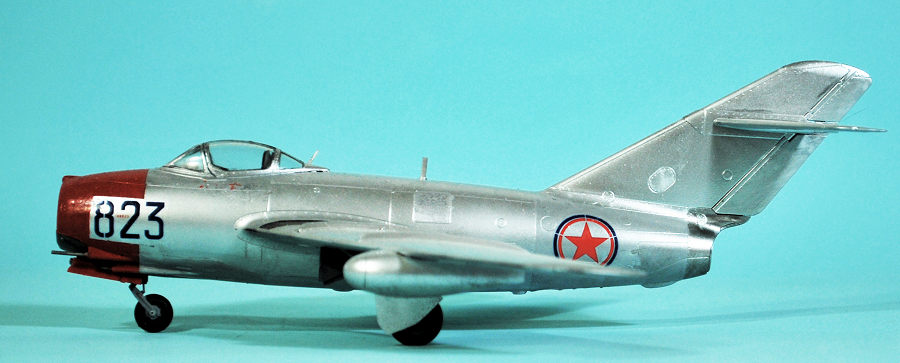
Bronco 1/48 MiG-15
| KIT #: | FB 4014 |
| PRICE: | @$40 delivered via China |
| DECALS: | Five options |
| REVIEWER: | Tom Cleaver |
| NOTES: | Xtradecal 48151 |

| HISTORY |
The Allies paid Germany the ultimate compliment of sending technical teams in the wake of the advancing armies to winnow through the records of German aviation companies and find every scientific and engineering paper and design, then to track down and obtain the services of every German aeronautical designer and engineer. The Western allies offered life in the United States or United Kingdom, bringing some 1,600 German scientists and engineers to the United States under Operation Paperclip. The Soviet Union’s Operation Osoaviakhim, saw more than 2,000 German scientists and engineers living in the Soviet Occupation Zone of Germany offered a trip to Moscow or a firing squad on the night of October 22, 1946; more than 23,000 Germans, including wives and children, were eventually moved to the Soviet Union.
Due to the geographic location of the factories, the Americans became inheritors of the work done by Willy Messerschmitt and the engineering and technical personnel of his company in Bavaria, while the Soviets found the records of Focke-Wulf’s Kurt Tank as well as those of Messerschmitt in the archives of the Reichluftfartsministerium (RLM - the German Air Ministry) in Berlin. Postwar jet fighter design in the United States would be influenced more by the work of Messerschmitt, while Kurt Tank’s ideas regarding jet fighter design were influential in the Soviet Union.
In March 1946, shortly after Soviet intelligence obtained performance information on the new American B-36 bomber, the Venno-Vozdushney Sily (V-VS, the Red Air Force) issued a requirement for a jet-powered bomber interceptor capable of a top speed of 1,000 km/h (621 mph) and an operational ceiling of 14,000 meters (45,932 feet), able to operate from unimproved airfields. The main problem for the Soviets in achieving such performance was the lack of a modern jet engine. The Germans had been unable to successfully develop high-powered jet engines before the end of the war, which limited the Soviets in what they could do since they were limited to using available German technology. They did get hold of early examples of the advanced axial compressor Junkers 012 and BMW 018 engines, but full development of these engines would take several years. Minister of Aviation Mikhail Khrunichev and designer Andrei. S. Yakovlev suggested to Joseph Stalin that an attempt be made to buy the conservative but fully developed Rolls-Royce Nene engine, which had the necessary power and could be reverse-engineered in minimum time. Stalin was said to have replied with incredulity, "What fool will sell us his secrets?"
As it turned out, the British Labour Government was foolish enough to do so. Prime Minister Clement Attlee was keen to promote a thaw in Anglo-Soviet relations. When the Soviet ambassador let it be known that Soviet scientists and engineers would welcome an opportunity to visit the Rolls-Royce factor to learn about British design, Atlee quickly made the invitation. A three-man Soviet trade mission, which included aircraft designer Artem Mikoyan and engine designer Vladimir Klimov - both of whom were entirely unknown in the West - visited Britain. Minister of Trade Sir Stafford Cripps was more than happy to approve purchase of 25 Nenes and a license for Soviet production, with the stipulation that the engines would only be used for civil purposes, to which the Soviets easily agreed.
The design staff at Grumman Aviation, which was currently trying to get hold of the Nene to power their XF9F-2 jet fighter prototype, were incredulous when they heard of the decision, as was nearly every other American involved in aircraft development. The American ambassador protested the decision to Atlee, who pointed to the Soviet agreement not to put the engines to military use. In the end, the Soviets never paid the license fee; when they were sued for it by Rolls-Royce, they refused payment on the grounds that both the RD-45 (the “reverse-engineered” Nene) and the Klimov VK-1 - the ultimate Soviet development of the Nene - were “essentially new” in design, and that they had never used the Nene as it was developed by Rolls-Royce, other than the 25 engines they had purchased initially.
Within a month of the arrival of the engines in the Soviet Union, Klimov and his design staff at Factory 45 were hard at work reverse-engineering the Nene for production as the RD-45. Both the Soviets and the Americans - after Grumman convinced General Electric to obtain a license to produce the Nene as the J-42 - took the largely hand-built Rolls-Royce product and modified it for mass industrial production, as Packard had done with the Merlin engine during World War II.
With
a suitable powerplant at hand, Artem Mikoyan and Mikhail Gurevich were ordered
to create a high-performance jet fighter to use the engine. The two designers
were determined to create an airplane that was a generation ahead of the jets
then being flown by Western air forces. They had the same swept-wing research
Edgar Schmued had found in Germany, and had gone so far as to produce a
swept-wing flying testbed in 1945, the piston-eng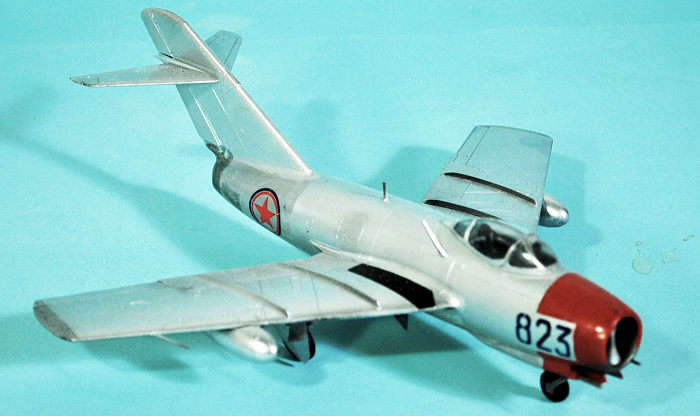 ined
"pusher"-layout, MiG-8 Utka (“Duck”). The commencement of work on what would
become the MiG-15 was only several months behind North American’s commencement
of redesign of the XP-86.
ined
"pusher"-layout, MiG-8 Utka (“Duck”). The commencement of work on what would
become the MiG-15 was only several months behind North American’s commencement
of redesign of the XP-86.
The I-310 that emerged had a wing swept at 37 degrees (commonly described as 35 degrees since that was the sweep angle of the main spar), close to what Schmued had found optimal, with the wing mounted mid-fuselage as had been the case with the MiG-9. It bore a general likeness to Kurt Tank’s Ta-183, which might have been the result of the Soviets having worked further on the wind-tunnel models of the Tank fighter that had been brought to the USSR. The fuselage had been “fattened” from the original design to make room for the centrifugal-flow Nene/RD-45 engine, which meant the airframe was less stable directionally and thus required an enlarged vertical fin and rudder from the original design; keeping the exhaust short to reduce loss of thrust meant the fin was swept at 56 degrees to put the rudder as far aft as possible to maintain directional control. This larger fin and rudder increased roll stability, reducing the ability to bank quickly, which was resolved by giving the wings two degrees of anhedral, which reduces roll stability. The one mistake made was to mount the horizontal stabilizer high on the vertical fin in the “T” position, which was done in order to place the horizontal stabilizers and elevators as far aft on the airframe as possible to increase pitching moment. The lack of the electrically-adjustable stabilizer developed by Messerschmitt, and the Russian failure to discover the all-flying tail until a shot-down F-86E was studied, meant that the MiG-15 would remain subsonic.
The Soviets were well aware of the American B-36 bomber, which was the obvious carrier of atomic bombs for any attack on the USSR, and the purpose of the MiG-15 was to climb to that bomber’s operating altitude of 45-48,000 feet, and blow the monster apart with cannon fire. Thus, the airplane was optimized for a high rate of climb and to fly at a maximum altitude of 50,000 feet. The heavy cannon armament of an N-37D 37mm cannon and two NS-23KM 23mm cannons was optimized for destruction of bombers. It would later be found over Korea that two hits by the 37mm cannon or 8 hits from the 23mm weapons was enough to bring down a B-29, and that one hit by the 37mm cannon was sufficient to knock down any F-86, F-84, F-80, F9F, or Meteor. The fighter was built strong for operation off primitive airfields; in combat this would mean that it would stand up well to the standard USAF fighter armament of six .50-caliber machine guns carried by the F-86. In fact, the F9F Panther, with its armament of four 20mm cannon would have greater individual success against MiG-15s, even though the first-generation Navy jet was otherwise inferior to the second-generation Soviet fighter.
Mikoyan and Gurevich used wing fences that were originally developed by Kurt Tank to control airflow over the swept wings at low speed (which Tank himself used when he developed the Ta-183 as the Pulqui II in Argentina in the early 1950s). The fences were not as effective as the slats of the F-86 were at low speed, though the “hard edge” wing gave better performance at higher speeds.
The I-310 prototype first flew at Ramenskoye on December 30, 1947, 90 days after George Welch had lifted the XP-86 off the Muroc lake bed. During that first, largely trouble-free flight, the prototype achieved a maximum speed of 1,042 km/h (647 mph) at 3,000 meters (9,800 ft). It was the second Soviet swept-wing jet to fly, following the flight of the Lavochkin La-160, a high-speed experimental test aircraft, on June 24, 1947. Further development demonstrated the designers had achieved their goals, though the lack of an all-flying tail limited maximum speed to 0.92 Mach, and in later tests the airplane exhibited a disturbing stall-spin that was difficult for an inexperienced pilot to recover from. Over Korea, American pilots would witness MiGs enter high-speed stalls then “swap ends” and snap end over end into a spin as they went out of control; this was caused by control reversal of the unboosted elevators due to sonic wave attachment to the high-placed tailplane, which led to “departure from controlled flight.” Below 162 knots airspeed, the airplane’s control became “soggy.” The manually-pumped pneumatic brakes faded fast and a too-fast landing would end up running out of runway as the brakes failed. Nevertheless, the MiG-15 was ordered into mass production, with the first production airplane taking flight on December 31, 1948.
The rushed development of both the engine and airframe led to initial operational problems. The Mean Time Between Failure of the Klimov RD-45 engine was less than ten hours. Metal for high-stress parts of both the airframe and engine was initially sub-standard, and production quality control in the factory was nearly non-existent with imprecise production tolerances. Performance difficulties with individual aircraft were traced to wings that didn’t exactly match. These production problems were reduced by the time the MiG-15 entered combat over Korea, but the handling problems remained. Lacking hydraulic flying controls, Soviet pilots quickly learned that if they could not shoot down a Sabre in a high-speed turning fight within the first third of the turn, the airplane would enter the deadly high-speed snap if they attempted to increase G-load and keep their turn tight enough to stay with the enemy fighter; at lower speeds, the MiG could out-turn its opponent, though if speed bled off below 330 knots, the Sabre’s slatted wing gave it the advantage. The lack of a G-suit meant that MiG-15 pilots could never turn as tightly as an American in his Sabre without blacking out.
As with the USAF, the V-VS assigned the first MiG-15s to elite units. The 324th IAD (Air Division) based at Kubinka outside Moscow, was the first unit to get the new fighter in early 1949. Seventy-five percent of the unit’s pilots were Great Patriotic War veterans. When they flew 45 MiG-15s over Red Square in Moscow for the 1949 May Day parade, Western military observers were shocked to see an airplane in service that so obviously was the equal of the F-86 that was just entering service. When 52 MiG-15s flew over the Tushino Air Show that July, it was proof the airplane was fully in service. Ninety MiG-15s flew over Moscow on November 7 to celebrate the 32nd anniversary of the October Revolution. By the time the Korean War erupted with the North Korean invasion, three V-VS fighter divisions, each equipped with 120 MiG-15s, were in frontline service. The first units equipped with the airplane had deployed to China in the spring of 1950, where they provided air defense; the MiG-15 scored its first aerial victory on April 28, 1950, when Major Keleynikov of the 29th GvIAP (Guards Air Regiment) shot down a Nationalist Chinese F-5E Lightning outside Shanghai.
One item
of difference between the two fighters would result in a significant difference
of results in air combat. That was the ergonomic design of the cockpits. The
Sabre’s cockpit was atop the jet intake, positioning the pilot high and giving
him good visibility over the nose. The fully-blown plastic canopy, the sides of
which were below the pilot’s sh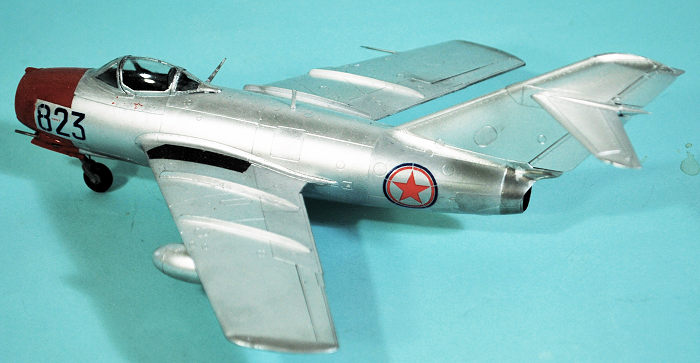 oulders,
conferred superb visibility, particularly to the ever-important “six o’clock,”
the position of choice for an attacker. The MiG-15 opted to place the pilot
lower in the airframe, with the jet intake bifurcated to go to either side of
the cockpit. Sitting lower in the cockpit, the MiG pilot had reduced visibility
over the nose. The canopy was made of two pieces of plexiglass, reinforced with
a relatively heavy frame. The canopy and seating reduced visibility to the rear.
Additionally, the fact the Sabre’s cockpit was pressurized while that of the MiG
was not led to a significant difference in pilot ability in high altitude
combat, since the Sabre pilot could breathe more easily than could his opponent.
oulders,
conferred superb visibility, particularly to the ever-important “six o’clock,”
the position of choice for an attacker. The MiG-15 opted to place the pilot
lower in the airframe, with the jet intake bifurcated to go to either side of
the cockpit. Sitting lower in the cockpit, the MiG pilot had reduced visibility
over the nose. The canopy was made of two pieces of plexiglass, reinforced with
a relatively heavy frame. The canopy and seating reduced visibility to the rear.
Additionally, the fact the Sabre’s cockpit was pressurized while that of the MiG
was not led to a significant difference in pilot ability in high altitude
combat, since the Sabre pilot could breathe more easily than could his opponent.
“Black Thursday”
At the end of February, 1951, UN Far East Commander General MacArthur ordered Brigadier General James E. Briggs, who had replaced Rosie O’Donnell as commander of FEAF Bomber Command, to increase pressure on Pyongyang. Briggs ordered 18 B-29s of the 98th Bomb Group to return to MiG Alley for the first time since December, to bomb Kogunyong, just south of the Yalu. Twenty-two F-80Cs of the 51st group were assigned as escorts. Unfortunately, the B-29s ran into unexpected headwinds and the waiting Shooting Stars were so low on fuel they had to abandon the mission and return to Taegu. The B-29s were forced to bomb without escort. MiGs from the 28th GvIAP (Guards Air Regiment), led by group commander Lt. Colonel V.I. Kolyadin, attacked and 10 B-29s were damaged, three so badly they were forced to land in South Korea. Two were claimed shot down and Colonel Kolyadin received credit for them; the Soviets admitted one MiG lost which was credited to a B-29 gunner.
The Sabres returned to MiG Alley for the first time since December on March 6, with 16 Sabres flying a patrol that went unopposed. The number of F-86s in-theater was only just keeping pace with the attrition rate. The 334th squadron’s Captain Richard Becker recalled, “We never had more than 16 aircraft in the air at one time in the beginning. We were usually outnumbered 5:1 in a fight, and sometimes as high as 10:1. It was not unusual for four Sabres to take on 30 to 40 MiGs.”
In late March, the Air Force’s 1st Radio Squadron, Mobile, operating in Japan, picked up Russian ground controllers in voice communication with Soviet aircraft operating over North Korea. This was an important intelligence windfall, since Soviet doctrine called for tight control of fighters by stations on the ground.
SAC commander General LeMay had been very reluctant to release the F-84s of the 27th Figher Escort Wing for Korea; he was particularly displeased that his elite fighter escorts were used as long-range fighter-bombers and pressured General Stratemeyer to return the Thunderjets to their escort role.
The weather finally broke on April 7, and 24 B-29s from the 98th and 307th groups targeted the newly-finished highway bridge at Uiju and the well-bombed railroad bridge at Sinuiju. The 27th wing provided close escort, with theF-84s flying parallel to the bomber stream as the same altitude, while four flights of Sabres provided high cover.
Thirty MiG-15s from the newly-arrived 324th IAD opposed the mission. The 324th, led by ranking Soviet (and Allied) World War II Ace of Aces General Ivan N. Kozhedub, had been in China since February 1950 before being sent to Manchuria in March. The 324th was one of the elite units of the Red Air Force, the first to equip with the MiG-15 at Kubinka outside Moscow, in 1949. The constituent units of the 324th - the 29th GvIAP, 176th GvIAP and the 196th IAP - contained several combat veterans of the Great Patriotic War. The 196th’s commander, Lt. Colonel Yevgeny Pepelyaev, was a believer in the adage “train hard, fight easy.” His pilots were experienced in dogfighting in pairs, flights, and larger formations. Pepelyaev stated, “My goal was to strive to meet the American standard, but even my pilots were not, man for man, as well trained as their American opponents.” The 324th IAD and the 303rd IAD that would follow it in May, were the two most dangerous units the Sabres would face in Korea. Pepelyaev would score 19 victories to emerge as the second-ranked ace of the war, while Captain Nikolai Sutyagin of the 303rd scored 21 victories to become the Ace of Aces in the Korean War.
The 324th’s first combat with the Americans took place on April 3, only 24 hours after arrival at Antung. Four MiGs of the 176th GvIAP attacked four Sabres south of the Yalu. One Sabre was claimed shot down, though Air Force records claimed it crashed because it ran out of fuel; this would become a common way for the Air Force to reduce the number of “official” combat losses. The Sabre pilots claimed three MiGs shot down, though the 176th regiment listed only one lost in combat, while two others returned so heavily damaged that they were scrapped; the Soviets could play the “official loss” game too.
On April 7, MiGs from the 196th intercepted B-29s and their F-84 escorts after slipping past the 16 Sabres on high cover. Captain Serafim Subbotin and Captain Ivan Suchkov were each credited with shooting down a B-29. Senior Lieutenant Andrushko was credited with shooting down an F-84, though he was in turn shot down himself by a 27th wing F-84. FEAF Bomber Command only listed one B-29 lost.
With the rail bridge at Sinuiju still unscathed, another mission was mounted. On Tuesday, April 12, 48 B-29s of the 19th, 98th and 307th groups went back, escorted by 39 F-84s from the 27th group. Nine Superforts aborted. As the American formation appeared on radar, the MiGs on alert at Antung were scrambled.
The 196th’s Captain Lev Ivanov was already airborne and was first to spot the B-29s. Diving through the escorting F-84s, he concentrated his fire on a B-29 of the lead formation, opening fire at 600 m (1,800 feet), with two short bursts that went low. He closed to 400 m (1,200 feet) and fired two more bursts. The bomber emitted smoke and dropped out of the formation. Ivanov’s wingman, Senior Lieutenant Kochegarov, set another B-29's wing tanks afire.
The 19th Bomb Group recorded the bombers were three minutes from “bombs away” when 30 MiG-15s hit the formation. They broke through the Thunderjet escorts and immediately shot down one bomber that caught fire and crashed short of the target. Six more were damaged.
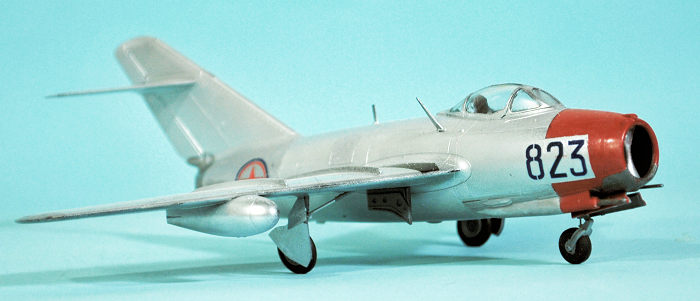 Veteran
navigator 1st Lieutenant Ralph Livengood of the 19th group’s 30th Bomb Squadron
described the attack: “Only six of our twelve bombers made it back to Okinawa.
One diverted to Itazuke with wounded crewmen. The pilot and bombardier of
another were killed, and the co-pilot flew back to crash-land at Taegu. A third
was badly hit by the MiGs and ditched in the Yellow Sea with no survivors. A
fourth crash-landed at Kimpo. The fifth was shot down by the MiGs in the initial
attack; there were no ‘chutes. Our tail gunner, S/Sgt Lyle Patterson, was
credited with shooting down a MiG, and our other gunners had one damaged and
another probable. When we got back to Okinawa, we had three rounds left in our
guns.” MiGs led by Captain Gregori Ges attacked the survivors of the 30th
squadron and claimed three more shot down in a running fight. This matches the
squadron’s officially-stated losses, though one of the three survived to
crash-land at Taegu.
Veteran
navigator 1st Lieutenant Ralph Livengood of the 19th group’s 30th Bomb Squadron
described the attack: “Only six of our twelve bombers made it back to Okinawa.
One diverted to Itazuke with wounded crewmen. The pilot and bombardier of
another were killed, and the co-pilot flew back to crash-land at Taegu. A third
was badly hit by the MiGs and ditched in the Yellow Sea with no survivors. A
fourth crash-landed at Kimpo. The fifth was shot down by the MiGs in the initial
attack; there were no ‘chutes. Our tail gunner, S/Sgt Lyle Patterson, was
credited with shooting down a MiG, and our other gunners had one damaged and
another probable. When we got back to Okinawa, we had three rounds left in our
guns.” MiGs led by Captain Gregori Ges attacked the survivors of the 30th
squadron and claimed three more shot down in a running fight. This matches the
squadron’s officially-stated losses, though one of the three survived to
crash-land at Taegu.
Senior Lieutenant Fukin engaged the escorts, closing on the tail of an F-84 that he mistakenly identified as an F-80 and put three bursts into the airplane; the right main gear dropped and it fell off as he flew past.
The B-29s of the 307th group approached the target independent of the other two groups, which made them vulnerable to attack. The MiGs led by Captains Sheberstov and Subottin attacked, claiming two shot down though the 307th group listed one shot down and another so badly damaged it crash-landed at Suwon. The group turned away and dropped their bombs short of the target.
The crews of the 98th group, last over the target, escaped attack. Soviet records state that the final group “encountered insufficient resistance from our fighters and managed to bomb the railway bridge.”
The MiG pilots claimed 11 B-29s and two escorting fighters identified as F-80s shot down. They had flashed past the Thunderjets, which were flying throttled back to stay with the slower bombers, as if they weren’t there. F-84 pilots claimed three probables. B-29 gunners were credited with seven; Soviet records record no losses.
The Sinuiju mission came to be known among FEAF Bomber Command crews as “Black Thursday.” FEAF was forced to conclude that B-29s could not be flown in MiG Alley during daylight hours. While only three were listed as lost over the target, with one crash landing in South Korea due to battle damage, 25 B-29s had been shot down or damaged by MiGs in the two missions. This was 25 percent of the total number of B-29s assigned to FEAF and far above the 10 percent loss rate deemed acceptable. General Stratemeyer banned further B-29 attacks on Sinuiju until an effective means of escort could be developed and informed Curtis LeMay that the Thunderjets were too slow and lacked the maneuverability to go against the MiG-15. From then on, whenever possible, escort missions were flown by the Sabres while the Thunderjet went on to become the leading fighter-bomber of the war. In the event, B-29s never attacked the Sinuiju bridges again, and did not fly in MiG Alley in daylight for six months. The MiG-15 had won the first round.
The tactics chosen by the two opponents were different due to the differences in performance parameters between the F-86 and the MiG-15. Captain Sergei Karamenko, a 12-victory ace in the Great Patriotic War who scored 13 victories in Korea, described the situation: “The Sabre was the most dangerous threat to my friends and I in Korean skies. Our MiG-15 and the F-86 belonged in the same class, similar types with similar performance. They differed only in that the MiG had an advantage in rate of climb at altitude, while the Sabre was superior in maneuvering, especially at low level. These advantages could not always be used, however. The fight, as a rule, was decided in the first attack. After the first pass, the MiG-15s reached for altitude, while the Sabres rushed for the ground. Each tried to reach the altitude where it held a distinct advantage, and thus the battle faded.” Captain Richard Becker, the second F-86 pilot credited with five victories (and the first whose claims are recognized in Soviet loss records),recalled: “After our first four or five missions, combat became like a boxing match. It was either him or me while protecting my wingman, but it was a fight to the death. It was also a short fight. Sometimes during an entire day of combat, a dogfight might last only four to eight minutes, but it was so violent that we were exhausted when we landed.”
While the MiG’s cannon armament was slower-firing, it only took one or two hits for a MiG to shoot down a Sabre. Captain Becker explained, “It only took one or two hits to be blown up, but I do know some pilots who were hit in the tail section who came back. If we were hit in the fuselage or near the engine with an explosive shell, it was the end. We were down.” In contrast, the lighter machine gun armament of the F-86 meant pilots had to get in close with the enemy to score killing blows. Becker recalled, “ I remember one MiG I shot down when I was within 300 feet with all six .50-caliber guns firing down his tailpipe, and in a short time, he blew up. It did not take a long burst. If we fired from 1,500 feet with a deflection shot, we had a problem.” Thus, the MiG pilots favored a single pass, trying to knock down a Sabre with one or two solid hits, while the Sabre pilots favored mixing it up, depending on their superior maneuverability to get in close and open fire.
Dick Becker summed up the experience of Sabre pilots over Korea in 1951: “There was no 10-to-1 kill ratio when I was there. The guys we flew against were good, and they were as committed as we were. Every fight that I was in was decided by the guy in the cockpit who was better able to take advantage of the moments presented by luck. The MiG-15 was a dangerous opponent. We were very evenly matched and I am certain that overall in that first year, we fought them to a draw.”
| THE KIT |
This MiG-15 kit, and a kit of the “definitive” MiG, the MiG-15bis, were released in the summer of 1950 to be sold at the Chinese Aviation Museum in Beijing, where the Chinese celebrated the 70th anniversary of China’s entry into the Korean War, a war they believe they won, due to the fact that ever since the other nations of the world have treated China with respect, rather than trying to carve the country up as was the case in the “Century of Shame” before the victory of the Communists in 1949.
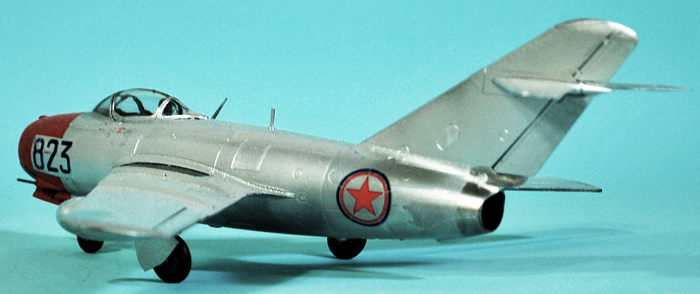 This kit is
the only 1/48 kit ever released of the first MiG-15, powered by the RD-45, and
flown in combat during 1950-51, a time known to USAF fighter pilots as “The Year
of the Honcho.” All the other available kits in this scale are the VK-1-powered
MiG-15bis, which didn’t enter combat in Korea until early 1952.
This kit is
the only 1/48 kit ever released of the first MiG-15, powered by the RD-45, and
flown in combat during 1950-51, a time known to USAF fighter pilots as “The Year
of the Honcho.” All the other available kits in this scale are the VK-1-powered
MiG-15bis, which didn’t enter combat in Korea until early 1952.
Because this kit was intended for sale primarily to “non-modelers,” it is a simplified version of the Trumpeter MiG-15bis released back around 2005. The Trumpeter history is demonstrated in the goofy rear wing fairing to the fuselage, which shouldn’t be “fish tailed”. As it comes in the box, it is essentially a “snap-tite” kit. This is not a bad thing! As compared to the earlier kit, it has been simplified, lacking the complete engine and other details such as the separate dive brakes that could be posed open. The fuselage is only divided into left and right halves, rather than also into fore and aft. The result is it is easier to assemble than the earlier kit. If one cuts off the large “snap-tite” attachment points, the parts can be assembled so tightly and precisely if done with care that the model will not need putty or filler on any joints.
Decals are provided for three aces of the Chinese People’s Volunteer Air Force, as the PLAAF units that fought in Korea were known. They are: Wang Hai and Zhang Baotong, tied for Chinese ace of aces with 9 credited victories each in 1951, and Le Han, credited with eight in 1951, including the first Chinese victory over a USAF fighter, an F-86 he shot down (according to the USAF’s cooked books, it was “heavily damaged” in combat and returned to Kimpo, where it never flew again) in September 1951. Additionally, one of the MiG-15s flown by Yevgeny Pepelyaev is an option, as is the MiG-15 which may have been flown by Lev Ivanov, one of the Soviet leaders in the fight on “Black Thursday.”
The “history” in the instructions is amusing; the MiG-15 is called “the world’s first practical jet fighter” (I guess the Me-262 was just “chopped liver”).
| CONSTRUCTION |
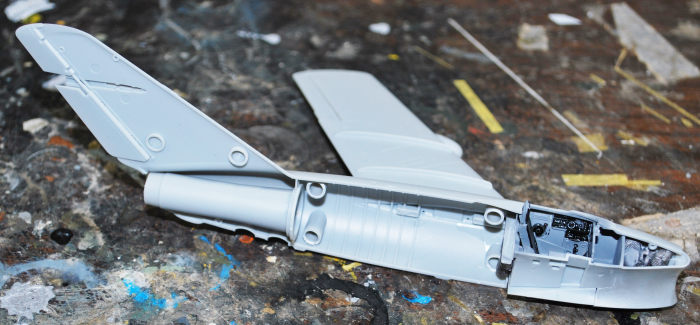 This is a
simple, straightforward build that offers no problems or difficulties if you
keep your wits about you. Overall, the best thing to do is cut off all those
snaptite connectors, because they prevent a good close fit, being so tight. If
you do that, you can glue it together (we’ve all done limited-run kits without
locating pins) tightly and close enough that no putty or filler of any kind will
be needed. If you’re bound and determined to be super-accurate, you can fill in
the “fish tail” wing fairing, and sand it to be the straight line. Leaving it
alone also works.
This is a
simple, straightforward build that offers no problems or difficulties if you
keep your wits about you. Overall, the best thing to do is cut off all those
snaptite connectors, because they prevent a good close fit, being so tight. If
you do that, you can glue it together (we’ve all done limited-run kits without
locating pins) tightly and close enough that no putty or filler of any kind will
be needed. If you’re bound and determined to be super-accurate, you can fill in
the “fish tail” wing fairing, and sand it to be the straight line. Leaving it
alone also works.
I started with the wings. I cut off the snaptite locators and opened locating holes for the slipper tanks, then glued each wing to the fuselage half so I could work the joint from inside and out and get it nice and tight and close, no putty or filler needed. The flap has nice detail as well as the flap well, but I closed it up because you see very few photos of these airplanes sitting on the tarmac with the flaps down. Most kits with a lowered-flap option only really assemble well by doing the flap down. This only needed to have the three locators cut off and it slipped right in. I also cut off the molded-on pitot tube, since it’s going to be knocked off. I drilled out a locating hole at the proper position and will glue it back in when the model is no longer being handled for construction or painting.
The fuselage is only in right/left halves, not also fore and aft since it doesn’t have the engine the Trumpy kit does. The dive brakes are closed and just represented by scribing. They get the correct smaller brakes for the first iteration of the MiG. This is fine – photos show the brakes closed along with the flaps up on most MiG-15s sitting on the tarmac. I glued the rudder to the vertical fin at this point to get it fitting just right.
The cockpit is easy to assemble, there’s not that much there, but if you close the canopy and keep the overall lines, what’s there is fine. I squeezed four fishweights and put them in the little “holding area” ahead of the cockpit in the intake assembly, then flattened and glued three others to the rear cockpit bulkhead, which is plenty of weight for nose-sitting.
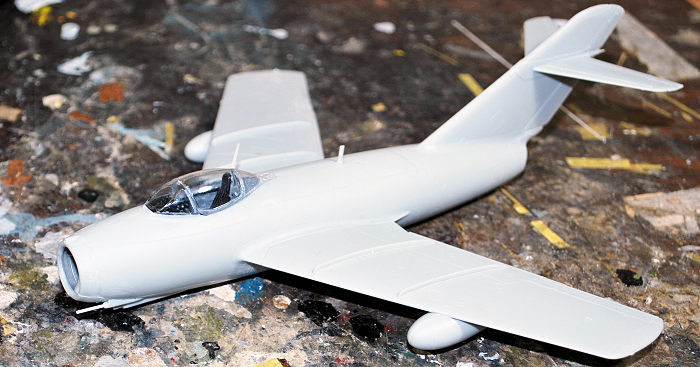 Do not
attach the gun tray to the cockpit assembly before putting the cockpit into the
fuselage. Cut off the snaptite locating pins and attach the tray after you glue
the fuselage together. With care and a little squeezing after applying glue, you
can get a nice tight fit and again not need putty or filler.
Do not
attach the gun tray to the cockpit assembly before putting the cockpit into the
fuselage. Cut off the snaptite locating pins and attach the tray after you glue
the fuselage together. With care and a little squeezing after applying glue, you
can get a nice tight fit and again not need putty or filler.
The two halves of the model glued together easily, I rubber-banded fore and aft of the wing and with care got a nice joint that only needed a light scrape-down followed by a minute with a fine-grit sanding stick to get rid of the centerline joint. I then glued on the horizontal stabs. I had to trim the locator tabs to fit. These are the correct smaller horizontal stabs for the early MiG-15.
This whole assembly to the point of being ready to paint took about 5 hours, and I was proceeding slowly, test-fitting, figuring out what to do like cut off the pins, etc. If you follow my idea about cutting off the pins and other suggestions, you can probably do it in less than that.
| COLORS & MARKINGS |
I first painted the red nose area and masked it off. Then I painted the model overall with Tamiya Gloss Black X-18, thinned 50-50 and misted on for a smooth finish as primer for the Vallejo metallic paints. The model was given an overall coat of Vallejo Aluminum, allowed to set up completely overnight, then it was masked off using low tack drafting tape, and various panels were painted with White Aluminum, Dull Aluminum, Semi-Matte Aluminum and Duraluminum.
Once I was finished, Jennings Heilig - who knows more about Soviet aircraft than I do - informed me that the MiGs in Korea were painted an overall monotone Aluminum Lacquer for corrosion control. For my taste, that makes for a very boring looking single-color model, but your commitment to accuracy vs. artistic look should determine your choices.
 A warning on
the decals: I was going to do one of the Chinese aces, but these decals will
stick immediately to the first thing they touch if there is not A LOT OF WATER
on the surface, and the slightest attempt to move them if there isn’t A LOT OF
WATER on the surface will result in them curling up and wiping themselves out. I
discovered that the hard way, screwing up the Bort numbers for all three
options, being a slow learner.
A warning on
the decals: I was going to do one of the Chinese aces, but these decals will
stick immediately to the first thing they touch if there is not A LOT OF WATER
on the surface, and the slightest attempt to move them if there isn’t A LOT OF
WATER on the surface will result in them curling up and wiping themselves out. I
discovered that the hard way, screwing up the Bort numbers for all three
options, being a slow learner.
So I did the version some sources claim for the Soviet pilot Lev Ivanov, who led the 30 MiGs that hit the B-29s on “Black Thursday” in April 1951, driving the B-29 from the daylight skies of North Korea. Pepelyaev’s Bort number marking is the only “done to death” MiG-15 marking I know of.
Another note on markings: according to a Russian modeler, the visual difference between Soviet-flown and Chinese-flown MiG-15s in Korea is that the Soviets used a North Korean national insignia without the white backing and also followed Soviet practice of not placing insignia on the upper surface of the wing, while the Chinese used the North Korean insignia with the white background and placed the insignia on upper and lower wing surfaces. There isn’t much out there on the markings of the other side in Korea, so this information scores 8.5 out of 10 on TSRTM scale (That Sounds Right To Me). And so this model has the insignia option without white backing, placed only on the lower wing surface and the fuselage.
| CONCLUSIONS |
Like I said, it’s a nice, simple, accurate, inexpensive kit. Simple, accurate and inexpensive is GOOD. A good placeholder until Eduard gets around to releasing their great 1/72 MiG-15s in 1/48, which they’re threatening to do in late 2021/early 2022. Did I mention it is the only early MiG-15 out there in 1/48? Yes, it is. And that’s the airplane that fought most of the battles in MiG Alley between the USAF and the PVO/Strany during “the year of the honcho.”
7 January 2021
Copyright Modeling Madness.com. All rights reserved
Review kit courtesy of my wallet.
If you would like your product reviewed fairly and fairly quickly, please contact the editor or see other details in the Note to Contributors.
Back to the Main Page Back to the Review Index Page Back to the Previews Index Page